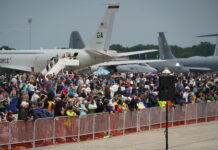In 2010, the United States Department of Homeland Security launched a public safety campaign called, “If you see something, say something.” Its mission was to increase public awareness of suspicious behavior by “bad actors.” The premise was to provide an outlet for citizens to alert the proper authorities to potential threats to safety, and to ensure that the citizens themselves remained vigilant. Simply put, if a person sees anything they consider suspicious, they should immediately say something to local or national law enforcement. This program has both a direct and an indirect correlation to the air show industry.
Recent terrorist attacks in North America and abroad have underscored the importance of such measures, not only throughout the world, but also in the air show industry. While studies maintain that the air show industry is a low likelihood target, it is critical that we employ a heightened vigilance so that we remain less likely to have an incident.
The hidden value of this campaign is revealed when we unpack the strategy and work the concepts into other facets of our business. If we consider the basic principle of, “If you see something, say something,” to be raising awareness of hazards, then the scope and obvious benefits of the initiative broaden. By empowering ourselves with the invitation to raise concerns, we improve the chances of quickly identifying risks.
If a parking attendant spots a gopher hole in a main thoroughfare and says nothing, there is a chance that patrons might injure themselves. However, if the parking attendant feels empowered – or even encouraged — to expose what they have found as a danger, then the probability that the hole will be repaired increases and the likelihood of a patron injury decreases. The same goes for any of the myriad of perils encountered during an air show, from golf cart hazards and exposed tent poles to unsecured hot pit areas and distracted performers.
Similarly, performers should feel as empowered as that hypothetical parking attendant to call attention to unsafe practices. If a performer finds an aspect of another performer’s routine to be of concern, then that performer should find a minute to discuss it with their fellow performer.. The concern may turn out to be unfounded, but the mere discussion can only lead to positive affirmation that performers are looking out for each other. Fostering this environment will have a rippling effect that could prevent an accident or incident further down the road. Even if a particular safety issue is not addressed during an informal chat between two performers, we are all helped and empowered if we know that we work in an atmosphere where friendly, pro-active, non-confrontational dialogue is encouraged. And, over time and inevitably, that kind of environment will result in actual hazards being identified and mitigated.
“If we don’t know it’s broke, we can’t fix it.” That’s a phrase many mechanics use, and it is the essence of this mindset. As an industry, we would do well to adopt it. The Safety Management System community learned years ago that the most effective implementation of these strategies only succeeds with top-down buy in. The leaders of an organization must encourage dialogue, and that is the case here. By inviting the entire air show community to the table, and communicating that the top level management at every air show embraces this philosophy, the greater a show’s ability will be to reduce the probability of a risk becoming an actual hazard.
It is easier to see something if you have more people willing to say something.








